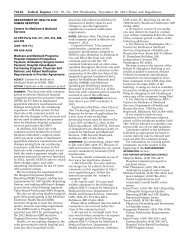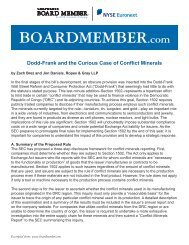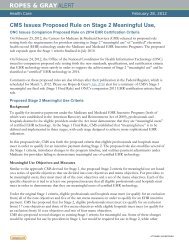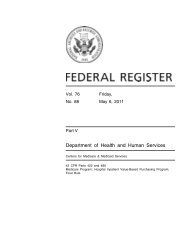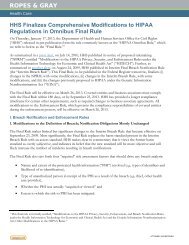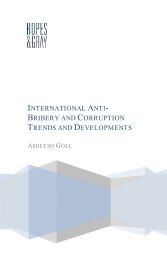SCOTT A. JALOWAYSKI - Ropes & Gray
SCOTT A. JALOWAYSKI - Ropes & Gray
SCOTT A. JALOWAYSKI - Ropes & Gray
Create successful ePaper yourself
Turn your PDF publications into a flip-book with our unique Google optimized e-Paper software.
May 16, 2011Q: In your observation, what regions are attracting private equity investments in Asia today?Mr. Jalowayski: China continues to attract a tremendous amount of capital. Funds are also actively looking atVietnam. A recent example of this is KKR investment in Masan Consumer. Japan continues to be an attractivemarket for private equity funds that have deep operating company and industry experience because of privateequity's skill in rationalizing businesses and creating value.Q: What are the macro trends in the antitrust approvals in China?Mr. Jalowayski: The Anti-Monopoly Law clearance mechanism contemplates an initial 30-day review period withinwhich concentrations that pose no substantive antitrust concern should be cleared. However, what is happening isthat in practice even concentrations that pose little substantive antitrust issues are being pushed into a 2nd phaseof review, which extends the review period for up to an additional 90 days. This is believed to relate primarily tothe volume of filings relative to the manpower resources in Ministry of Commerce PRC (MOFCOM) rather thanincreased scrutiny of transactions on MOFCOM's part, but it nonetheless has the potential to delay closings inPRC M&A transactions.Q: From a legal perspective, what are the risks for managing in-bound transactions in China?Mr. Jalowayski: From an acquirer's perspective the overall risks are very similar for private equity and strategicacquirers and this is a result of PRC government attitudes becoming more favorable towards private equityinvestors. On a marco-level, corruption is an on-going issue in high-risk jurisdictions such as China and India. It isno secret that China is a difficult environment for doing due diligence on companies. The recent revelationsregarding China Forestry underscore the risk. So I would say that simple business fraud is the single biggest risk.These factors together with the US Department of Justice's focus on PE Funds and certain industries in China(such as pharma, distribution) contribute to significant risks that require planning.Q: How can private equity firms plan for pre- and post acquisition?Mr. Jalowayski: Pre-investment, buyers need to carry out robust, thoughtful and targeted legal due diligence andinstitutionalize an appropriate level of checks and balances to dispassionately assess the risks of potential deals.Post-investment, FCPA (Foreign Corrupt Practices Act) and anti-corruption policies and procedures need to bedeveloped and implemented. In the case of PE funds, the nature of such policies and procedures may varydepending on factors such as the specific industry the target operates in and the degree of the fund's control overthe target's operations and governance.Q: What are the chief obstacles faced by private equity firms in acquiring assets in China today?Mr. Jalowayski: For foreign PE houses, the PRC's limitations on foreign exchange, which, together with limitationsin the existing PRC Company Law, make it difficult to effectively push down offshore leveraged financing to a PRCoperating company. This remains the most difficult challenge faced by PE firms in acquiring PRC assets. Assetscan technically be acquired but without being able to add leverage to increase returns, the investment propositionbecomes potentially unattractive. It is one of the themes driving the push towards Renminbi (RMB) funds, and oneof the reasons for growth equity activity in the form of minority stakes.Q: What is the nature of ownership structures that technically constitutes a buyout vs. a minority stake? How doesPRC compare with other Asian markets?Mr. Jalowayski: In a leverage buyout, a holding company owned by a PE fund purchases an operating company.The funds used to purchase the operating company come from equity contributions by the fund as well as debtfinancing from banks. Following the purchase of the target, the PE backed holding company is usually merged intothe operating company so that the operating company effectively becomes the borrower and cash generated fromthe opco's business is used to repay the debt. This deal structure isn't possible in the PRC, and it is alsoextremely difficult for an onshore subsidiary to guarantee an offshore holding company's debt. So, it is difficult tostructure and execute a traditional LBO deal in the PRC because banks are generally reluctant to lend to entitiesthat do not own the assets of the business. The legal framework in many other jurisdictions in Asia enables LBOstructures including Japan, Korea and Taiwan--though each has its own level of complexities. Generally speaking,minority investments or "buy-ins" are smaller and typically do not use leverage, hence are easier to execute.Reprinted by permission from dealmaker SPOT•LIGHT©. Published weekly on-line www.globalmanetwork.com




